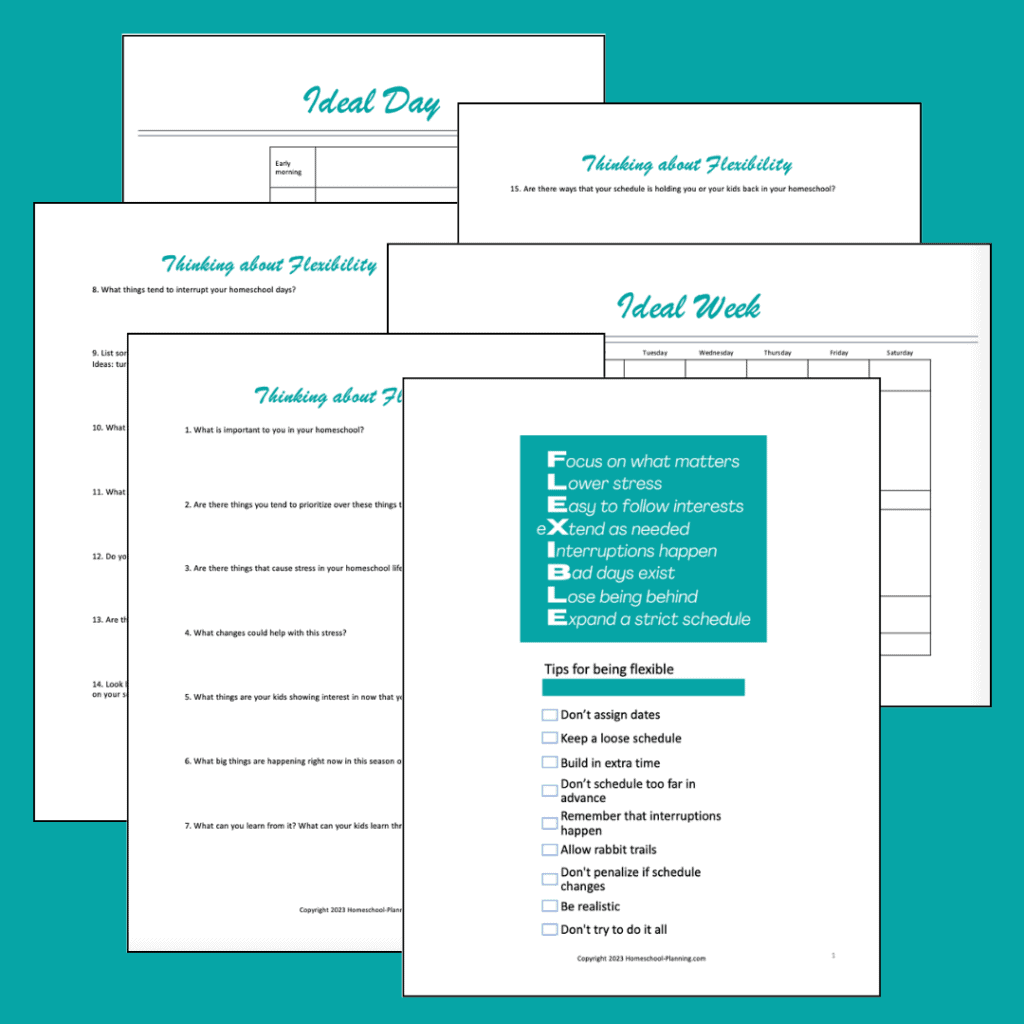A flexible homeschool schedule may seem at first glance an oxymoron. But is it?
As homeschool moms, we have to deal with so many things at once. For many, the best way to deal with this is to become a strict, scheduled, and structured person.
While this may help us in some ways, it can keep us from being able to deal well with the many unexpected things that come our way. Like children! 😂
Of course, not being flexible will cause many other issues. So today we will discuss some practical tips on how you can have a flexible homeschool schedule.

Why Flexibility?
Flexibility is important. When homeschooling, we have the freedom to arrange our schedules and curriculum but we often run into unexpected challenges. But when we are flexible, we can roll with the punches life brings! That’s why flexibility is important for your homeschool schedule.
Read: Most Vital Tool in your Homeschool Schedule
Being flexible allows us to adapt to changing circumstances, adjust plans, and make room for the unexpected. Here are some more ways this important tool can help us:
- Focus on what matters
- Lowers stress
- Makes it easy to follow interests
- You can extend as needed
- Accept that bad days exist
- Learn that interruptions happen
- Lose the feeling of being behind
- Expand a strict schedule
For more thoughts on flexibility and how it can help your homeschool schedule, check out my other post on flexibility, The Most Vital Tool in Your Homeschool Schedule.

How to Have a Flexible Homeschool Schedule
Now that you hopefully can see how flexibility can help you, let’s tackle some very practical ideas for ways you can become more flexible with your homeschool schedule!
1. Don’t assign dates
When you are planning out your homeschool year or even your homeschool week, you may be tempted to assign each lesson to a date. But I recommend you stop this.
Most curriculums and even planners are not set up this way. You are told to write down math lesson one on day one and history lesson 23 on the 23rd day of school. There’s a chart at the front of the book with a schedule by the week. Which week are you on again?
And what happens when your son cries through the math lesson? Do you have to force him to push through? Or do you double up on math tomorrow? No! Just take another day on math.
Yes, your schedule will be off. This is why all the grids and charts are so confining and don’t work for most people! This is why people say they aren’t planners. They need a more flexible plan!
So don’t assign a date. I mean, I don’t even assign a day of the year (1-180) to my kid’s work anymore. Like lesson #30 of 150? Scrapped too.
All the things are on a list. When we finish one lesson in science, we just move on to the next thing on the list! Each subject is worked at it’s own speed. That’s being flexible.

2. Keep a loose schedule – general time blocks
Time blocking is a helpful way to work through your day and get lots done. Blocking out chunks of time for specific tasks can help you to really focus in on what needs to be done in your day.
But I recommend rather than blocking out 20 minutes for math at 9 am, then 20 minutes for history, and so forth. That you think in bigger chunks of time for more general topics, like 2 hours for all of school.
School is school. When your child finishes one thing, they can move to the next and so on. If they are done early, great! If they run longer on something, that’s ok too.
As homeschoolers, we don’t have to run on a time clock or be ruled by a school bell.
Allowing your children to complete a task to the end in the time that is needed rather than completing a block of time will allow them to work to their best ability, not having to switch tasks just because it’s time.

3. Build in extra time
You may be someone who really likes to run things on a tight schedule and this not-using-bells thing just won’t work for you. Ok, I’ll accept that. But I ask that you build in extra time to your schedule.
Build in extra minutes for those times that your child needs to complete that thought in the writing assignment since they’re on such a roll. Or when they just can’t put down the book cause it’s so good. And of course for those times that they need some more time on their math cause it’s hard today.
Add in extra hours in your days to allow them to pursue their interests and just be kids. To dive into the art project or build legos or find whatever it is they love to do without having to stop. Getting “in the zone” is a real thing.
Build extra days into your annual schedule for the times that you all wake up on the wrong side of the bed and just need to take it easy. Or for that amazing field trip opportunity that just popped up. Build in extra days cause, well, life happens. You’re gonna need it.
It doesn’t have to all be drudgery.

4. Don’t schedule too far in advance
If you have things you must associate with days in advance within your homeschool, try not to schedule too far in advance.
When I was a new homeschooler, I got easily overwhelmed with organizing all the books and page numbers. I wanted an easy way to accomplish school each day without much thought.
I came across a couple different approaches to accomplish all the planning at once for the whole year so it’s all already done. One is planning out each day’s plans into a planner. The other is called the crate system, where you seperate each day’s work into a folder labeled by the day or week of the school year. Seems great!
The trouble with each of these plans is that when executing them, we quickly got off track in one subject or another. We weren’t even a month or two into the year, and I rearranged the entire year, scratching things off my list or moving pages from one folder to another.
later tried doing each of these systems, just for only a couple months in advance. It worked better, but still not great. I quickly learned that I either needed to plan only a couple weeks at a time, or come up with an even more flexible system.
I chose a more flexible system and started using undated lists as mentioned above. But if that doesn’t work for you or if you need to schedule things to a date, then I highly suggest to not plan very far in advance.
I have found that math in particular should not be planned too far in advance. I often cannot predict how long my kids will need on a given lesson or topic, so planning in advance produces lots of mess on my planned schedules!
Many moms will plan their homeschool weeks as they come. Or maybe one month at a time. Some can stretch the plans to 6 weeks.
You could even plan the whole year in advance, but add dates to schedule things only a little in advance. This is closer to what I do now. If planning far in advance, keeping the plans very loose and flexible is helpful.

5. Remember that interruptions happen
Something I try to remember and instill in my children is that people are most important. This is something I try to live by. So when someone needs some extra hugs, my work gets put down. When a friend calls crying, I answer.
I do try to treat homeschooling as my job though. So we don’t schedule other things in the morning when possible. School is what we do.
But life happens. People get sick, we have babies, we take trips, and we have bad days. Kids have a rough time and just can’t. Sometimes someone calls or visits and they just need to get my full attention.
School is priority and we can’t do it all, but sometimes life happens and people have to be more important. So sometimes school doesn’t happen as planned.
The way I deal with this is to have built-in time to allow for this flexibility. I don’t schedule my whole day or week or year. I do schedule, but everything has flexibility. There is margin everywhere.
I plan in advance a general idea of how many days of school we need and when. I plan on doing school every weekday. But I hold them lightly. I don’t dig in my heels.
Some days it doesn’t happen, so I make the days up later in the year. Cause I’ve also allowed for extra time in the year for this reason. It’s gonna be ok.

6. Allow rabbit trails
My son and I have recently developed an interest in the cold war. It started with a random book I came across about the history of the atomic bomb. It’s called Bomb. He’s always had an interest in the World Wars, so I got it from the library and showed it to my son. He quickly devoured it and then so did I. It’s so good!
That book has led to other books we’ve enjoyed by the same author, Steve Sheinkin, that are all great for history. And today he discovered a mini-series on the cold war. So now those books and videos are part of school for him – though I won’t tell him that. I will add them to my lists and try to allow time for him to work through them and be a little lax on some other things I had planned.
Why am I doing this? Because I can.
I understand that real learning doesn’t have to be in chronological order all the time. Sometimes we can’t plan it. But when I see that excitement in my kid’s eyes, why should I make him stop reading that book and make him read something else cause it’s “on my list?”
Allow the rabbit trails. Feed them. Carve out the time. Change the plans. Who knows where these interests will lead someday?

7. Don’t penalize if schedule changes
This is one of my personal homeschool soapboxes. So buckle up.
What happens when you miss a day in history cause of a doctor’s appointment? What happens to your plans if your child needs to re-do a math assignment?
I see that you have about 3 options:
- Do the lesson tomorrow on top of whatever else is planned.
- Force them to do it in the car or through tears. It must. get. done. today.
- Push all the lessons for the subject forward a day and finish it tomorrow. No stress.
I hear this conundrum over and over again. And what do most people say? Number 1, we make it up! They are so locked in to their plans and schedule that they can’t see any other way.
I’ve even seen people suggest you do extra work one day so you “can” go on a field trip tomorrow. WHAT??? Way to ruin a field trip, mom! Who do you need permission from?
‘m stepping all over everyone’s toes now. I know it. Please don’t penalize your kids if your schedule changes.
What if they didn’t finish their lunch cause they were full. Are you going to force them to finish their lunch along with their dinner? What if it’s your fault for overloading their plate? I’m gonna guess you won’t encourage overeating in that way.
We don’t have to act like public schoolers and have our kids do ‘homework’ cause they didn’t finish it today in class. We don’t have to force them to go to Saturday school because they had a doctor’s appointment.
You are the master of your homeschool schedule. Give them a day. Take a day. Just go on the field trip. Enjoy the outdoors and take a day of rest.
Just because you can. And don’t feel guilty about it. The lessons will get done. The days will get completed – or not. That’s fine too!

8. Be realistic
For the longest time, I had it in my head that we had to be finished with our schoolwork by noon every day. It was my ideal.
But we are not a family that gets started to school super early. I try for 9 am, but in reality many days, we’re not starting till 10. So I was skipping some things I really wanted to do with my kids because I still wanted to be done by noon.
Of course, that’s my choice. But I constantly felt guilty.
So somewhere along the way, I gave in to the fact that I can’t have it all the ways. I can’t start later and get done by noon and do everything I want to do with my kids.
Something had to give because reality is a thing. I chose to do what I want to do with my kids and just do a little school in the afternoon too rather than forcing us all to an earlier schedule that wasn’t natural. This gives us all an easier morning and that is helpful for us.
So adding flexibility into your schedule still requires reality. There are still limitations of life and time and all the other things besides homeschooling.
You can’t follow all the rabbit trails and finish all the curriculum and still get a long break in the summer (most of the time). Something usually has to give. So keep reality as part of your schedule, whatever that may look like for you.

9. Don’t try to do it all
You cannot and will not be able to do everything you want to do in one year. I’m assuming your kids are not seniors in high school, so you still have time. And even if they are, they have their whole lives ahead of them to learn!
With that time ahead of you, you can spread things out. It’s a marathon, not a sprint. All the books don’t have to be read this year alone. They have their whole lives. just get them a good start.
When we start with a lighter view of our schedules, it can make adding some margin and flexibility a little easier to take in.
If your curriculum schedules out all of your 180 days, maybe skip some stuff, don’t finish it, or choose a different curriculum. You don’t have to do it all. You don’t have to schedule every school day.
Read: Do we have to finish our homeschool curriculum?
I like to keep our curriculum to around 120-150 days when possible. The other days can be field trips, coop days, fun days, “bleed over” days where we finish what we started another day.
I also try to keep our days lighter, finishing by lunchtime when possible. Some days will go longer, but I’ve allowed for that.
When I don’t try to fill in our days and weeks with all the things, I have built-in flexibility to our schedule.

Free printable worksheets
With all this information, you now have the tools you need to apply more flexibility to your own homeschool. Make it happen today with these free flexibility worksheets!
Filled with tips, guided questions, and even schedule templates, you can think through your entire schedule today.
Write out your goals, find stress points, and discover ways to address them. Then actually design a new weekly and daily schedule to apply!
Download your free set of printable worksheets today!
Flexible Homeschool Schedule
I hope you are now seeing not only the importance of being more flexible as a homeschool mom, but also how it can help you. And now with these practical tips, you should be able to flex in your days and weeks this year as you homeschool your children.
Remember to keep plenty of margin in your schedule and start with a light schedule. You can’t and shouldn’t do it all. Be easy on your kids, enjoy them, and try not to penalize for changes in your schedule. It will all work out in the end! Those little people in your care will thank you for it.
How do you make your homeschool more flexible?
Related Posts
Most vital tool for your homeschool schedule
How to plan your annual homeschool schedule with free printable worksheets












